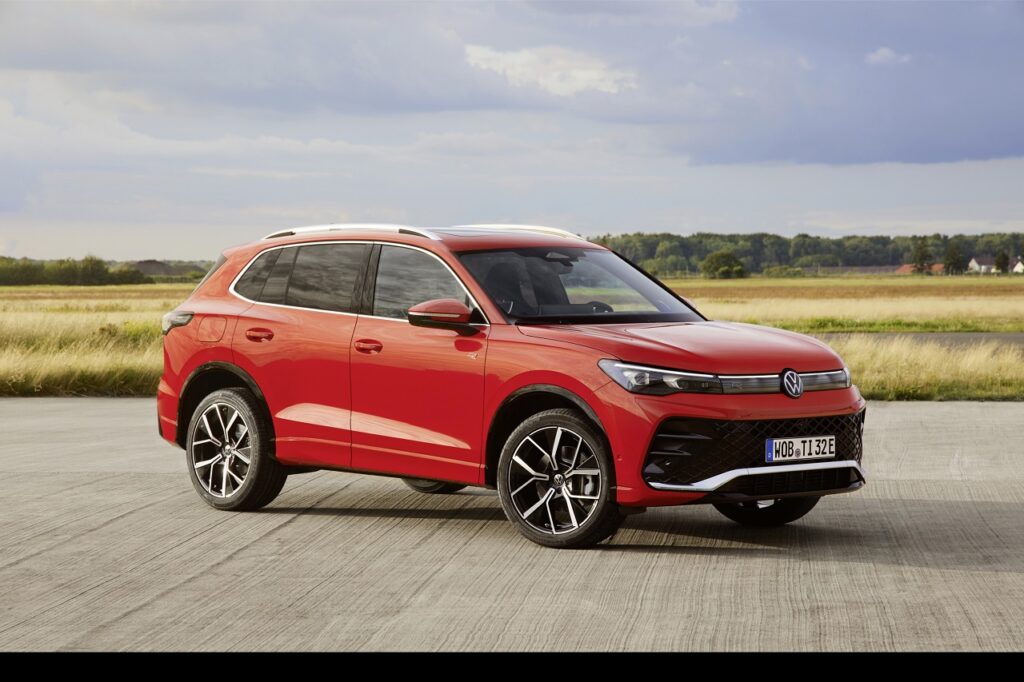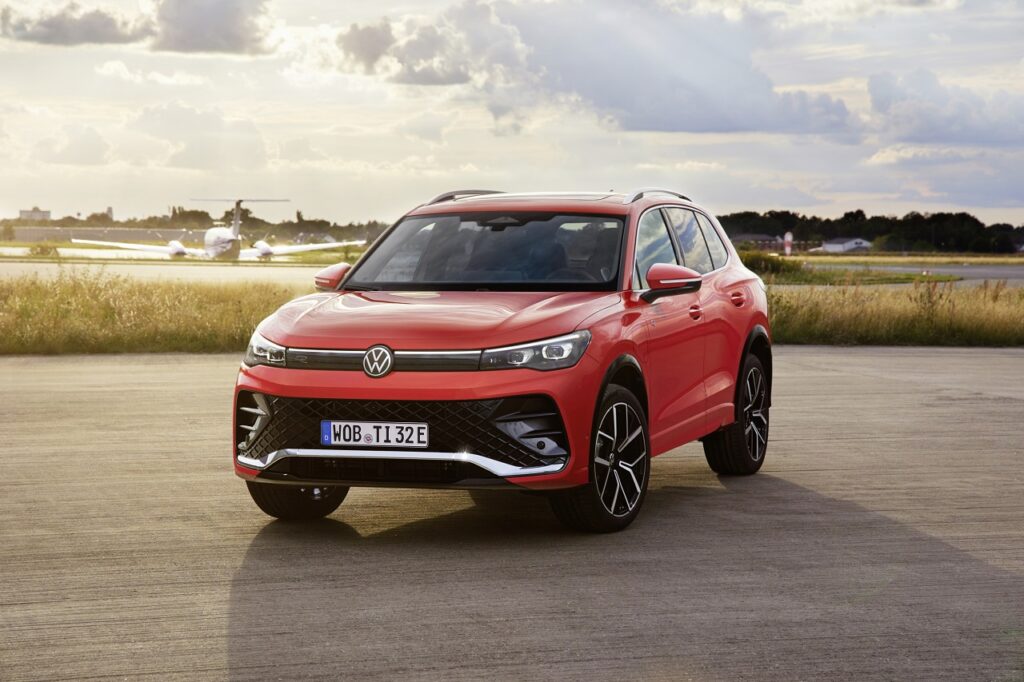- New Tiguan generation launches with progressive technologies and charismatic design
- New plug-in hybrid drives permit electric range of about 62 miles and fast DC charging
- New interior with clearly structured Digital Cockpit, infotainment screen, head-up display and driving experience switch is intuitive to use and based on specific customer feedback
- New adaptive chassis control system DCC Pro2, a piece of technology from the premium class, ensures maximum comfort and ultimate agility
Wolfsburg – In a world premiere, Volkswagen is presenting the all-new Tiguan1 and with it the third generation of the best seller. The Tiguan is one of the most successful Volkswagen models in the world today. More than 7.6 million buyers have chosen the compact SUV since its debut in 2007. The new model will reach dealerships as early as the first quarter of 2024.

Kai Grünitz, Brand Board Member for Technical Development: “The latest evolutionary stage of the Modular Transverse Matrix (MQB evo) forms the highly innovative technical basis of the third generation of the Tiguan. Thanks to the large economies of scale of the MQB evo, Volkswagen is once again democratizing numerous high-tech developments such as the DCC Pro or the new hybrid drives with an electric range of about 62 miles and making them available to hundreds of thousands of drivers.”
The new technological developments realised with the MQB evo improve the Tiguan in practically every area. New hybrid drives with an all-electric range of about 62 miles make this SUV more efficient than ever before. In addition, AC charging will be faster in all eHybrid versions, and fast DC charging will also be possible as standard for the first time. A cleanly designed Digital Cockpit based on the MIB4, the fourth-generation modular infotainment matrix, offers the highest level of information and brings digital services and apps on board. The operating concept is designed to be consistently self-explanatory. In addition, new systems such as a pneumatic massage function for the front seats2 or the IQ.LIGHT HD matrix headlights2 – used for the first time in the Tiguan – are derived from the premium Touareg model. The new adaptive chassis control DCC Pro2 optimises comfort and dynamics. The latest Park Assist2 generation automates driving in and out of parking spaces.
Expressive design and improved aerodynamics. The compact SUV comes with a completely new design. As a particularly striking feature, the front of the vehicle has a powerful look with flat LED headlights and glass-covered horizontal strip. The radiator grille openings are now located at the outer sides of the bumper, where air curtains ensure optimum air routing. The cleanly designed front end highlights the fact that the drag coefficient has improved from 0.33 to 0.28. This silhouette is characterised by athletic shoulders over the wheel housings (with up to 20-inch wheels). A new horizontal LED strip2 adds emphasis to the unmistakeable Tiguan rear end.
New cockpit and infotainment system generation. The interior of the Tiguan features a completely new concept and design. It stands out with its high standards of material and workmanship. In addition, the new cockpit landscape is intuitive to use, closely integrated, and has a clean and smart design. The modules include the new Digital Cockpit (digital instruments with anti-reflective coating in tablet landscape format), an infotainment screen that measures up to 38 centimetres (15 inches) 2 and has an entirely new menu structure and graphics, a new head-up display2 (projections on to the windscreen) and a new multifunction driving experience switch with integrated OLED display. This new rotary control with its own mini screen can be used to control the driving profile, radio volume or also the background lighting colours. In contrast, numerous vehicle and infotainment functions can be easily adjusted using natural language with the new IDA voice assistant2.
Efficient range of drives. Thanks to MQB evo, various drive types can be implemented in the Tiguan. For example, there will be a turbo diesel engine (TDI), turbo petrol engines (TSI), mild hybrid turbo petrol engines (eTSI) and plug-in hybrid systems (eHybrid), which will be offered exclusively in conjunction with the automatic direct-shift gearbox (DSG) in the future. Like on the Volkswagen ID. models and the new Passat, the gear position will be changed in future by means of a steering column switch on the right of the steering wheel with a self-explanatory operating principle. The switch is turned forwards to “D” to drive forwards and backwards to “R” to reverse, while the parking brake is activated by pressing the side of the switch. All Tiguan models additionally have paddles behind the steering wheel.

Electronically controlled running gear for added convenience and dynamics. The MQB evo provides the basis for a new running gear generation. Alongside a host of individual measures, Volkswagen has revamped the adaptive chassis control DCC: with the optional DCC Pro with two-valve shock absorbers2. The new model is additionally equipped as standard with a Vehicle Dynamics Manager – an MQB system that made its debut in the current Golf GTI3. The system controls the functions of the electronic differential locks (XDS) and the lateral dynamics components of the controlled shock absorbers in the DCC Pro system. Wheel-specific braking interventions and selective changes in the shock absorber hardness lead to greater comfort and enhanced performance during dynamic cornering. This makes the vehicle handling more stable, agile and precise.
Seats for long distances. The new ergoActive seats2 with pneumatic four-way lumbar adjustment and pneumatic 10-chamber pressure massage function are a perfect match for the high-quality character of the Tiguan. In addition, there is a programming function for automatic activation of the seat heating or seat ventilation at certain outside temperatures.
HD headlights in the Tiguan for the first time. The Tiguan is the first MQB model to be launched with the newly developed IQ.LIGHT HD matrix headlights2. The interactive lighting system was also developed in parallel for the premium-class Touareg – both SUVs therefore share the same basic design of the headlights. HD stands for High Definition, meaning a high resolution of the light sources. In the case of the Tiguan, a total of 38,400 multipixel LEDs (19,200 multipixel LEDs per headlight) illuminate the road and the surrounding area to a completely new level and therefore improve comfort and safety.

High-performance assist systems. The Tiguan is equipped with a large number of convenience and assist systems as standard. In addition to Side Assist (lane change system), Front Assist (Autonomous Emergency Braking), Lane Assist (lane keeping system) and Rear View (rear view camera system), these also include Dynamic Road Sign Display. There will also be an extensive range of optional systems. These include among others the following technologies: Park Assist Pro with remote parking capability (for automatic driving into and out of parking spaces controlled by the driver from outside the vehicle using a smartphone app) or also Trailer Assist (for assisted manoeuvring with a trailer).
Larger luggage compartment in the Tiguan. The new Tiguan has increased in length by approximately three centimetres. The height, width and wheelbase remain practically identical to the predecessor. The luggage compartment capacity of the new generation shows just how good the use of space is: although the SUV is only slightly longer, its luggage compartment capacity has increased by 37 litres to 652 litres (when loaded up to the height of the rear seat backrests).
1 Near-production concept car. The vehicle is not yet available for sale.
2 Line-dependent or optional equipment
3 Golf GTI – Fuel consumption in l/100 km: combined 7.4-7.0; CO₂ emissions in g/km: combined 167-160. Only consumption and emission values in accordance with WLTP and not in accordance with NEDC are available for the vehicle. Where ranges are stated, the values for consumption and CO₂ emissions depend on the selected vehicle equipment.